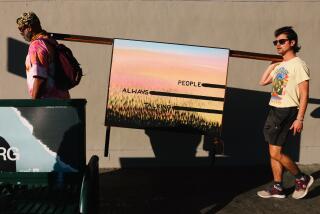Lewis, Clark Route Ready for Close-Up
- Share via
WARRENTON, Ore. — The explorers were exhausted and hot when the Lewis and Clark expedition came up the Missouri River near what is now Bellevue, Neb., on July 22, 1804.
“Set out verry early with a view of Getting to Some Situation above in time to take equal altitudes and Observations as well as one Calculated to make our party Comfortabl in a situation where they Could recive the benifit of a Shade,” William Clark wrote in his journal.
The idea of some R&R; there apparently caught on. Today, a house with a swimming pool overlooks the spot where they are believed to have camped.
In a project that has spanned five years, University of North Texas photography professor Brent Phelps is retracing the Lewis and Clark trail, photographing what it looks like today.
The explorers would be hard-pressed to recognize most of it, although Phelps says a few spots appear relatively undisturbed.
The Amon Carter Museum at the Fort Worth campus will publish a book of his work for the Lewis and Clark bicentennial in 2004-06, and two traveling shows of Phelps’ pictures will be taken to museums across the country.
Phelps says it is the first undertaking of its kind.
“The previous projects tried to give it a 19th-century twist,” he said, attempting to show what the explorers actually saw. “It will be a unique contemporary document, combining photography with historical text. I’d like to see it done again, 100 years from now.”
He noted that Olin Wheeler retraced the route during the Lewis and Clark centennial 100 years ago. There were some pictures in the two volumes he published, but it was mostly a verbal account.
“Very few sites today look the way Lewis and Clark found them,” he said. “There are some. It depends on how closely you look.”
His photos run the gamut from the relatively pristine Two Medicine Fight site in Montana, where a skirmish with the Blackfoot tribe was the only armed conflict during the expedition, to the top of the U.S. West building in Omaha, where he shot down on a former Lewis and Clark campsite.
Even though the Two Medicine Fight site looks untouched, he said, “If you look closely enough you can see some cultural evidence.”
The Mandan Indian village near present-day Washburn, N.D., where the explorers spent the winter of 1804-05, has a power plant nearby.
A site west of Billings, Mont., is occupied by Oscar’s Dreamland, an amusement park complete with elephant rides.
The portage route around the falls near present-day Great Falls, Mont., goes through Malmstrom Air Force Base, which houses a helicopter-rescue unit.
And the Missouri River, home and highway for the Voyage of Discovery until the explorers neared its source in 1805, has moved over the decades, Phelps said, sometimes by a couple of miles, leaving some places where the explorers walked and camped under water.
The most visible evidence of Lewis and Clark is at Pompey’s Pillar, Mont., where Clark added his name to the Indian petroglyphs on July 25, 1806, on the voyage home. It has been preserved, and Phelps photographed it.
“This rock, which I shall call Pompey’s Tower, is 200 feet high and 400 paces in secumphrance and only axcessable on one Side,” Clark wrote in his journal, which paid little attention to modern rules of spelling or capitalization. “The nativs have ingraved on the face of this rock the figures of animals near which I marked my name and the day of the month & year.”
Phelps said he became interested in the explorers while on a summer trip through Montana 15 years ago.
“I had seen references to Lewis and Clark, but I didn’t pay any attention to them,” he said. But roadside interpretive signs eventually piqued his interest, and he realized the bicentennial was approaching.
“I had a second-grade understanding of Lewis and Clark,” he said. “I did some research to see what had been done.”
He said he was unaware of Stephen Ambrose’s best-selling book about the expedition, “Undaunted Courage,” until he got the idea for his project. Phelps now travels with unabridged copies of the explorers’ journals and a Linhof Technorama panoramic camera.
He has taught photography for 21 years, but when he’s not teaching, he’s on the road with the Lewis and Clark project.
Phelps returned to Texas to teach in early January and plans to return to the Northwest next fall to complete his shooting.
The book and exhibits are to be ready by the fall of 2004.
Phelps said that even since he began the project he has seen changes in some of the places he revisited.
“Probably for me, the project is never going to end,” he said.
*
On the Net:
National Council of the Lewis & Clark Bicentennial:
www.lewisandclark200.org/
More to Read
Sign up for The Wild
We’ll help you find the best places to hike, bike and run, as well as the perfect silent spots for meditation and yoga.
You may occasionally receive promotional content from the Los Angeles Times.






